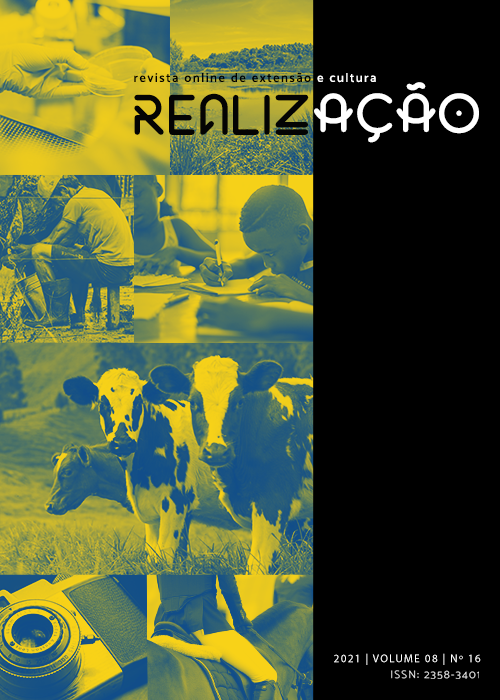Consciência fonológica na educação infantil: uma análise de práticas pedagógicas
DOI:
https://doi.org/10.30612/realizacao.v8i16.15105Palavras-chave:
Intervenção Pedagógica. Habilidades. Crianças.Resumo
O artigo traz uma investigação cujo objetivo foi analisar e refletir sobre o desenvolvimento da consciência fonológica - a habilidade que temos em manipular os sons de nossa língua/capacidade de percebermos que uma palavra pode começar ou terminar com o mesmo som - e como se dá esse processo na prática pedagógica com crianças pequenas da Educação Infantil. Realizaram-se estudos bibliográficos sobre a temática Consciência Fonológica, bem como pesquisa empírica em turmas de Pré-Escola em uma instituição educativa no município de Dourados/MS. A pesquisa foi desenvolvida a partir de uma abordagem qualitativa de cunho exploratório. Verificou-se que a preocupação em desenvolver a consciência fonológica nas crianças esteve presente realizando-se atividades de maneira lúdica e com a participação das crianças, assim como o quanto é essencial o aprimoramento de tais habilidades para beneficiar e facilitar o processo de aquisição da leitura e escrita nas crianças, especialmente por elas estarem iniciando sua aprendizagem escolar. Conclui-se ainda que o docente precisa estar capacitado no sentido de compreender a importância, a necessidade e o conhecimento acerca destes processos, visando criar possibilidades e experiências que levem as crianças ao desenvolvimento de suas potencialidades, levando-as plenamente à aquisição da língua falada, escrita, bem como a leitura e interpretação.
Downloads
Referências
ADAMS, M.; FOORMAN, B.; LUNDBERG, I.; BEELER, T. Consciência fonológica em crianças pequenas. Porto Alegre: Artmed, 2006.
BIMONTI, Rafaela de Paula. A importância da consciência fonológica na educação infantil. São Paulo, v.1, 2008.
BORGATTO, Ana Maria Trinconi; BERTIN, Terezinha; MARCHEZI, Vera. Ápis – Letramento e Alfabetização. 2. ed. São Paulo: Ática, 2014.
BRASIL. Lei nº 8.069. Estatuto da Criança e do Adolescente. Brasília, 1990. Disponível em: <https://www.gov.br/mdh/pt-br/centrais-de-conteudo/crianca-e-adolescente/estatuto-da-crianca-e-do-adolescente-versao-2019.pdf> Acesso em: 05 abr. 2021.
BRASIL. MINISTÉRIO DE EDUCAÇÃO. SECRETARIA DE EDUCAÇÃO BÁSICA. Brinquedos e brincadeiras nas creches: manual de orientação pedagógica. Elaboração do texto final Tizuko Kishimoto e Adriana Freyberger. Ilustrações de Luis Augusto Gouveia. Brasília: MEC/SEV, 2012. Disponível em: < http://portal.mec.gov.br/dmdocuments/publicacao_brinquedo_e_brincadeiras_completa.pdf> Acesso em: 07 abr. 2021.
CAPOVILLA, A.G.S, & CAPOVILLA, F.C. Treino de consciência fonológica de pré a segunda série: efeitos sobre habilidades fonológicas, leitura e escrita. Temas sobre Desenvolvimento, 1998; 7(40), 5-15.
FERREIRO, Emilia. Com todas as letras. São Paulo: Cortez, 1993.
FERREIRO, Emilia; TEBEROSKY, Ana. Psicogênese da língua escrita. Porto Alegre: Artes Médicas, 1985.
GIL, Antônio Carlos. Métodos e técnicas de pesquisa social. 5. ed. São Paulo: Atlas, 1999.
KISHIMOTO, Tizuko M. Brinquedos e brincadeiras na Educação Infantil. ANAIS DO I SEMINÁRIO NACIONAL: CURRÍCULO EM MOVIMENTO – Perspectivas Atuais. Belo Horizonte, novembro de 2010.
LAKATOS, Eva Maria, MARCONI, Maria de Andrade. Fundamentos de metodologia científica. 5. ed. São Paulo: Atlas, 2003.
MAGDA, Soares. Alfabetização: a questão dos métodos. São Paulo: contexto, 2016.
MORAIS, Artur Gomes de. Consciência fonológica na educação infantil e no ciclo de alfabetização. 1. ed. Belo Horizonte: Autêntica, 2019.
MORAIS, Artur Gomes de. Sistema da escrita alfabética. São Paulo: Melhoramento, 2012.
MORAIS, Artur Gomes de. O desenvolvimento da consciência fonológica e a apropriação da escrita alfabética entre crianças brasileiras. Revista Brasileira de Alfabetização. Vitória: v. 1, n. 1, p. 59 – 76, jan./jun. 2015.
SMOLKA, Ana Luiza Bustamante. A criança na fase inicial da escrita: a alfabetização como processo discursivo. São Paulo: Cortez, 1993.
Downloads
Publicado
Como Citar
Edição
Seção
Licença
Copyright (c) 2022 Andreína de Melo Louveira Arteman, Priscila Demeneghi da Silva Vargas

Este trabalho está licenciado sob uma licença Creative Commons Attribution-NonCommercial-ShareAlike 4.0 International License.
Autores que publicam nesta revista aceitam as normas de publicação, bem como, concordam com os seguintes termos:
(a) O Conselho Editorial se reserva ao direito de efetuar, nos originais, alterações da Língua portuguesa para se manter o padrão culto da língua, respeitando, porém, o estilo dos autores.
(b) Autores mantêm os direitos autorais e concedem à revista o direito de primeira publicação, com o trabalho simultaneamente licenciado sob a Creative Commons Atribuição-NãoComercial-CompartilhaIgual 4.0 Internacional que permite: Compartilhar — copiar e redistribuir o material em qualquer suporte ou formato e Adaptar — remixar, transformar, e criar a partir do material. A Creative Commons Atribuição-NãoComercial-CompartilhaIgual 4.0 Internacional considera os termos seguintes:
- Atribuição — Você deve dar o crédito apropriado, prover um link para a licença e indicar se mudanças foram feitas. Você deve fazê-lo em qualquer circunstância razoável, mas de nenhuma maneira que sugira que o licenciante apoia você ou o seu uso.
- NãoComercial — Você não pode usar o material para fins comerciais.
- CompartilhaIgual — Se você remixar, transformar, ou criar a partir do material, tem de distribuir as suas contribuições sob a mesma licença que o original.
- Sem restrições adicionais — Você não pode aplicar termos jurídicos ou medidas de caráter tecnológico que restrinjam legalmente outros de fazerem algo que a licença permita.


